(CNN) -- The world is OK -- at least this time -- and scientists are psyched. An asteroid dubbed 1998 QE2 whizzed past Earth on Friday, with its own moon in tow. "#asteroidQE2 has sailed harmlessly past Earth," NASA's Jet Propulsion Laboratory tweeted around 5 p.m. ET. It got within about 3.6 million miles of our planet. That's close relatively given the vastness of space, but still more than 15 times the distance from wherever you are to our moon. The fly-by had astronomers less fearful and more excited about getting the "best look at this asteroid ever," according to NASA. The resulting images should be of similar quality to those obtained when spacecraft get up close to asteroids, Lance Benner of NASA's Jet Propulsion Laboratory said. Scientists have been rubbing their hands for a decade and a half for this opportunity since they discovered the asteroid on August 19, 1998, the year for which it is named. The letter "Q" stands for the month of August. "As my old friend, radar astronomer Steve Ostro used to say, spaceship Earth is making a fly-by of the asteroid, so we're going to exploit the capabilities of the radars to understand as much as possible," Benner said, according to a story on NASA's website.  Bill Nye: Asteroid is much bigger Bill Nye: Asteroid is much bigger  Will NASA land astronauts on asteroids? Will NASA land astronauts on asteroids? 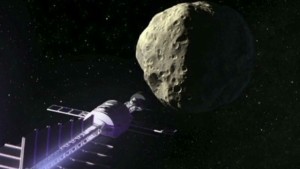 Asteroid threats and budget realities Asteroid threats and budget realities 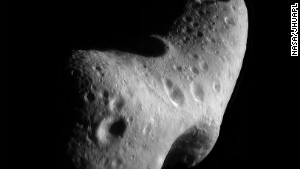 How to save Earth from asteroids How to save Earth from asteroids A milestone asteroid 1998 QE2 represents a milestone in NASA's Near Earth Object Project, which scopes out the heavens for potential danger from celestial projectiles whizzing past. "It's one of the initial successes of our effort to find the big asteroids that could hit the Earth and cause global catastrophe," said Paul Chodas, a scientist with the project. "It's certainly one to keep an eye on." NASA has been tracking it with radar devices since Thursday, not to clock its speed but to get good pictures of it. A day before, scientists got a shot of its moon. The images look less like photos and more like ultrasound images. The discovery of its moon -- which makes it what scientists call a binary asteroid -- surprised the astronomers, said NASA radar scientist Marina Brozovic, who helped take the images at Deep Space Network antenna at Goldstone, California. More than 15% of asteroids travel in groups of two or three objects revolving around one another, according to NASA. Destructive potential 1998 QE2's moon, which is 2,000 feet wide, is large enough for NASA to term it a "potential city killer." The asteroid it revolves around is much bigger, at 1.7 miles wide. "This is one of the big ones," Chodas said. 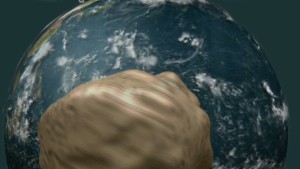 How we can stop a 'doomsday' asteroid How we can stop a 'doomsday' asteroid  Will NASA land astronauts on asteroids? Will NASA land astronauts on asteroids? Large explosion on moon visible from earth Any asteroid as large as a half-mile across would cause a global catastrophe, if it struck the blue planet, he added. To put the potential for damage by an asteroid into perspective, the one that paleontologists believe triggered the extinction of dinosaurs on Earth 65 million years ago was six miles in diameter. The meteor that exploded over Russia in February, injuring more than 1,000 people and causing millions of dollars in damage, was a "very small asteroid," according to the space agency. The most dangerous asteroids contain a lot of stone or iron, according to NASA. 1998 QE2 contains a good bit of carbon and well as amino acids, the building blocks of protein. The NEOP has identified 95% of asteroids of this most dangerous order, Chodas said. Luckily, there is no known possibility of one slamming into the planet. But NASA has not yet done much work on the meteors one class lower, known as the "potential city killers." They start at a size of 150 yards in diameter. NASA astronomers have identified only 10% of the 10,000 they believe pass close to Earth. NASA officials this year told a congressional panel, which was considering future defense systems to prevent a potential asteroid strike, that there is only a one in 20,000 chance that a truly dangerous one will hit Earth in a year's time. Having a look Even as it jets further and further away, astronomers will continue making images of 1998 QE2 through June 9 with two radar antennas -- one in California and a second one in Puerto Rico. Amateur astronomers with telescopes as small as 10 inches long may just barely be able to see it in the southern skies. But their devices should be computer controlled because locating it otherwise will be difficult, NASA advises. The coordinates to locate the asteroid are on the Jet Propulsion Laboratory website. NASA takes threats from asteroids seriously, and will keep calculating the orbits of the large ones they identify long to check their flight paths for any potential danger to Earth. Eventually, 1998 QE2 will curve back out toward the solar system's outer asteroid belt, which is just short of Jupiter. It gets its next shot at hitting Earth in 200 years. At this point, scientists believe history will repeat itself, and our planet will once again survive. via Science - Google News http://news.google.com/news/url?sa=t&fd=R&usg=AFQjCNE-b7okIauJx6W-Va-MR6KdZqoF9A&url=http://www.cnn.com/2013/05/31/world/earth-new-asteroid/index.html | |||
| | |||
| | |||
|
Home »Unlabelled » Large asteroid safely zips past Earth, dragging its moon along - CNN International
Friday, 31 May 2013
Large asteroid safely zips past Earth, dragging its moon along - CNN International
Debarjun Saha | 20:33 |
Subscribe to:
Post Comments (Atom)
Search
#
Popular Posts
-
PTI : Washington, Tue Oct 01 2013, 15:42 hrs < img src="http://static.indianexpress.com/m-image...
-
The High Altitude Venus Operational Concept program would eventually send a manned mission to the atmosp...
-
The same day that Amazon announced a trial run of its delivery by drone service in India , a couple of MIT...
-
http://aggressiveseiag.cryptoumoneybox.cn
-
Biologist Vladimir Dinets spent years studying the behaviour of crocodiles He saw crocodiles pushing ...
-
https://cryptstonener.com/5?kjBhVgFCcgd*grfhGVjhbNJNHGBVTFrDCRT*tfRcgH
-
First private DNA forensic lab in India's ...
-
Hi there! I regret to inform you about some sad news for you. Approximately a month or two ago I have succeeded to gain a total access t...
-
Hi! Sadly, there are some bad news that you are about to hear. About few months ago I have gained a full access to all devices used by y...
-
Redirect Notice Redirect Notice The previous page is se...
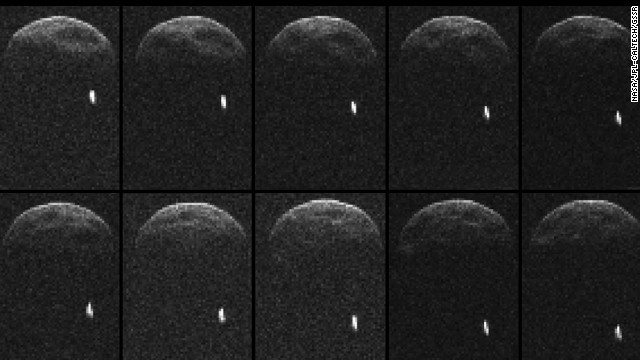 Asteroid 1998 QE2 about 3.75 million miles from Earth. The white dot is the moon, or satellite, orbiting the asteroid.
Asteroid 1998 QE2 about 3.75 million miles from Earth. The white dot is the moon, or satellite, orbiting the asteroid. 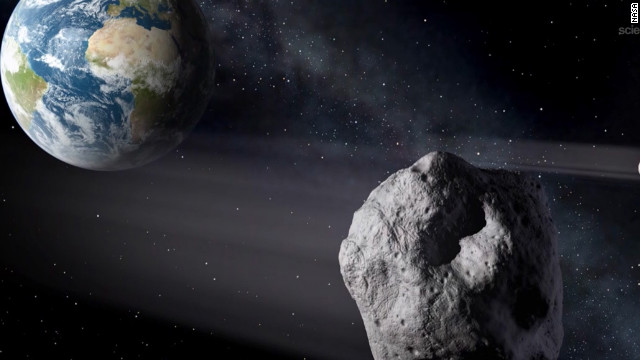 Asteroid 2012 DA14 made a record-close pass -- 17,100 miles -- by Earth on February 15. Most asteroids are made of rocks, but some are metal. They orbit mostly between Jupiter and Mars in the main asteroid belt. Scientists estimate there are tens of thousands of asteroids and when they get close to our planet, they are called near-Earth objects.
Asteroid 2012 DA14 made a record-close pass -- 17,100 miles -- by Earth on February 15. Most asteroids are made of rocks, but some are metal. They orbit mostly between Jupiter and Mars in the main asteroid belt. Scientists estimate there are tens of thousands of asteroids and when they get close to our planet, they are called near-Earth objects. 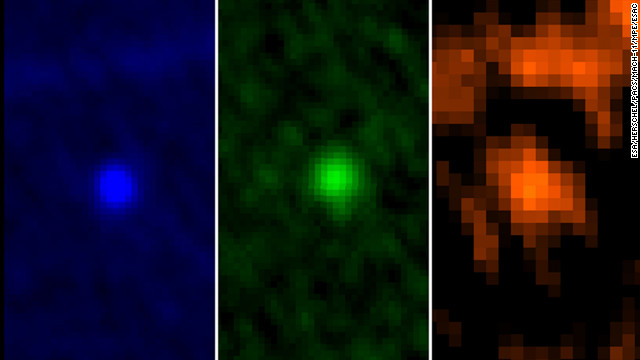 Another asteroid, Apophis, got a lot of attention from space scientists and the media when initial calculations indicated a small chance it could hit Earth in 2029 or 2036. NASA scientists have since ruled out an impact, but on April 13, 2029, Apophis, which is about the size of 3½ football fields, will make a close visit -- flying about 19,400 miles (31,300 kilometers) above Earth's surface. The images above were taken by the European Space Agency's Herschel Space Observatory in January 2013.
Another asteroid, Apophis, got a lot of attention from space scientists and the media when initial calculations indicated a small chance it could hit Earth in 2029 or 2036. NASA scientists have since ruled out an impact, but on April 13, 2029, Apophis, which is about the size of 3½ football fields, will make a close visit -- flying about 19,400 miles (31,300 kilometers) above Earth's surface. The images above were taken by the European Space Agency's Herschel Space Observatory in January 2013.  If you really want to know about asteroids, you need to see one up close. NASA did just that. A spacecraft called NEAR-Shoemaker, named in honor of planetary scientist Gene Shoemaker, was the first probe to touch down on an asteroid, landing on the asteroid Eros on February 12, 2001. This image was taken on February 14, 2000, just after the probe began orbiting Eros.
If you really want to know about asteroids, you need to see one up close. NASA did just that. A spacecraft called NEAR-Shoemaker, named in honor of planetary scientist Gene Shoemaker, was the first probe to touch down on an asteroid, landing on the asteroid Eros on February 12, 2001. This image was taken on February 14, 2000, just after the probe began orbiting Eros. 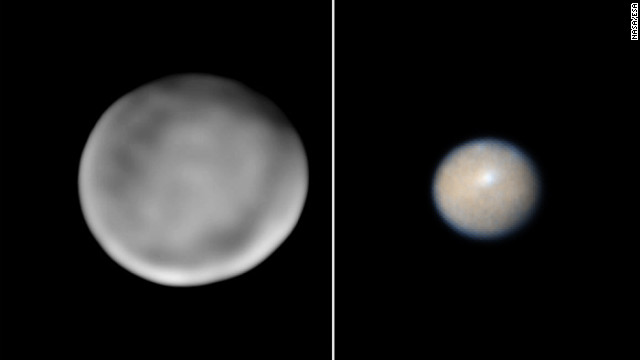 The first asteroid to be identified, 1 Ceres, was discovered January 1, 1801, by Giuseppe Piazzi in Palermo, Sicily. But is Ceres just another asteroid? Observations by NASA's Hubble Space Telescope show that Ceres has a lot in common with planets like Earth. It's almost round and it may have a lot of pure water ice beneath its surface. Ceres is about 606 by 565 miles (975 by 909 kilometers) in size and scientists say it may be more accurate to call it a mini-planet. NASA's Dawn spacecraft is on its way to Ceres to investigate. The spacecraft is 35 million miles (57 million kilometers) from Ceres and 179 million miles (288 million kilometers) from Earth. The photo on the left was taken by Keck Observatory, Mauna Kea, Hawaii. The image on the right was taken by the Hubble Space Telescope.
The first asteroid to be identified, 1 Ceres, was discovered January 1, 1801, by Giuseppe Piazzi in Palermo, Sicily. But is Ceres just another asteroid? Observations by NASA's Hubble Space Telescope show that Ceres has a lot in common with planets like Earth. It's almost round and it may have a lot of pure water ice beneath its surface. Ceres is about 606 by 565 miles (975 by 909 kilometers) in size and scientists say it may be more accurate to call it a mini-planet. NASA's Dawn spacecraft is on its way to Ceres to investigate. The spacecraft is 35 million miles (57 million kilometers) from Ceres and 179 million miles (288 million kilometers) from Earth. The photo on the left was taken by Keck Observatory, Mauna Kea, Hawaii. The image on the right was taken by the Hubble Space Telescope. 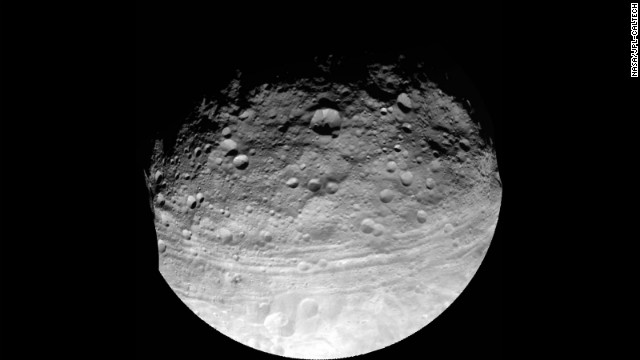 One big space rock got upgraded recently. This image of Vesta was taken by the Dawn spacecraft, which is on its way to Ceres. In 2012, scientists said data from the spacecraft show Vesta is more like a planet than an asteroid and so Vesta is now considered a protoplanet.
One big space rock got upgraded recently. This image of Vesta was taken by the Dawn spacecraft, which is on its way to Ceres. In 2012, scientists said data from the spacecraft show Vesta is more like a planet than an asteroid and so Vesta is now considered a protoplanet. 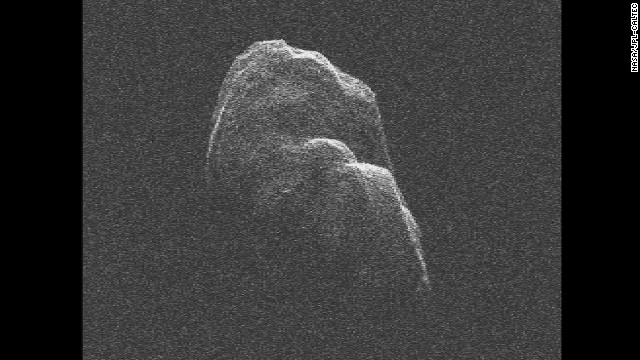 The three-mile long (4.8-kilometer) asteroid Toutatis flew about 4.3 million miles (6.9 million kilometers) from Earth on December 12, 2012. NASA scientists used radar images to
The three-mile long (4.8-kilometer) asteroid Toutatis flew about 4.3 million miles (6.9 million kilometers) from Earth on December 12, 2012. NASA scientists used radar images to 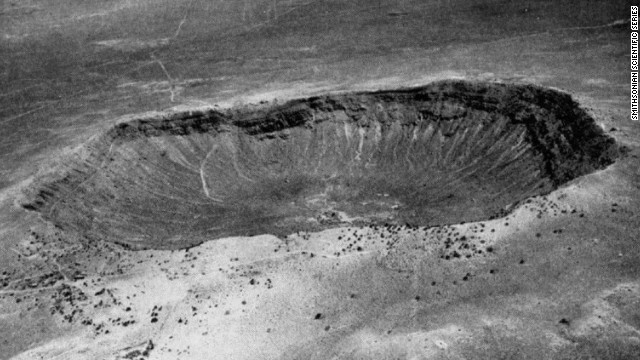 Asteroids have hit Earth many times. It's hard to get an exact count because erosion has wiped away much of the evidence. The mile-wide Meteor Crater in Arizona, seen above, was created by a small asteroid that hit about 50,000 years ago, NASA says. Other famous impact craters on Earth include Manicouagan in Quebec, Canada; Sudbury in Ontario, Canada; Ries Crater in Germany, and Chicxulub on the Yucatan coast in Mexico.
Asteroids have hit Earth many times. It's hard to get an exact count because erosion has wiped away much of the evidence. The mile-wide Meteor Crater in Arizona, seen above, was created by a small asteroid that hit about 50,000 years ago, NASA says. Other famous impact craters on Earth include Manicouagan in Quebec, Canada; Sudbury in Ontario, Canada; Ries Crater in Germany, and Chicxulub on the Yucatan coast in Mexico.  NASA scientists say the impact of an asteroid or comet several hundred million years ago created the Aorounga crater in the Sahara Desert of northern Chad. The crater has a diameter of about 10.5 miles (17 kilometers). This image was taken by the Space Shuttle Endeavour in 1994.
NASA scientists say the impact of an asteroid or comet several hundred million years ago created the Aorounga crater in the Sahara Desert of northern Chad. The crater has a diameter of about 10.5 miles (17 kilometers). This image was taken by the Space Shuttle Endeavour in 1994. 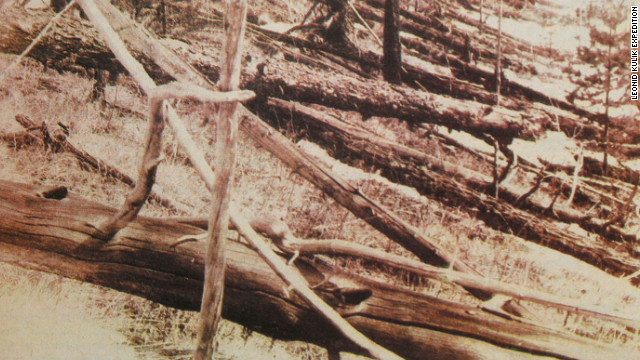 In 1908 in Tunguska, Siberia, scientists theorize an asteroid flattened about 750 square miles (1,200 square kilometers) of forest in and around the Podkamennaya Tunguska River in what is now Krasnoyarsk Krai, Russia.
In 1908 in Tunguska, Siberia, scientists theorize an asteroid flattened about 750 square miles (1,200 square kilometers) of forest in and around the Podkamennaya Tunguska River in what is now Krasnoyarsk Krai, Russia.  What else is up there? Is anyone watching? NASA's
What else is up there? Is anyone watching? NASA's  One of the top asteroid-tracking scientists is Don Yeomans at the Jet Propulsion Laboratory, which is managed by the California Institute of Technology. Yeomans says every day, "Earth is pummeled by more than 100 tons of material that spewed off asteroids and comets." Fortunately, most of the asteroid trash is tiny and it burns up when it hits the atmosphere, creating meteors, or shooting stars. Yeomans says it's very rare for big chunks of space litter to hit Earth's surface. Those chunks are called meteorites.
One of the top asteroid-tracking scientists is Don Yeomans at the Jet Propulsion Laboratory, which is managed by the California Institute of Technology. Yeomans says every day, "Earth is pummeled by more than 100 tons of material that spewed off asteroids and comets." Fortunately, most of the asteroid trash is tiny and it burns up when it hits the atmosphere, creating meteors, or shooting stars. Yeomans says it's very rare for big chunks of space litter to hit Earth's surface. Those chunks are called meteorites. 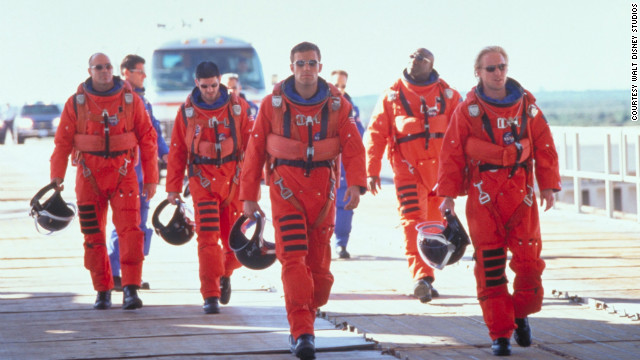 Asteroids and comets are popular fodder for Earth-ending science fiction movies. Two of the biggest blockbusters came out in 1998: "Deep Impact" and "Armageddon." (Walt Disney Studios) Others include "Meteorites!" (1998), "Doomsday Rock" (1997), "Asteroid" (1997), "Meteor" (1979), and "A Fire in the Sky" (1978). Can you name others?
Asteroids and comets are popular fodder for Earth-ending science fiction movies. Two of the biggest blockbusters came out in 1998: "Deep Impact" and "Armageddon." (Walt Disney Studios) Others include "Meteorites!" (1998), "Doomsday Rock" (1997), "Asteroid" (1997), "Meteor" (1979), and "A Fire in the Sky" (1978). Can you name others? 













No comments:
Post a Comment